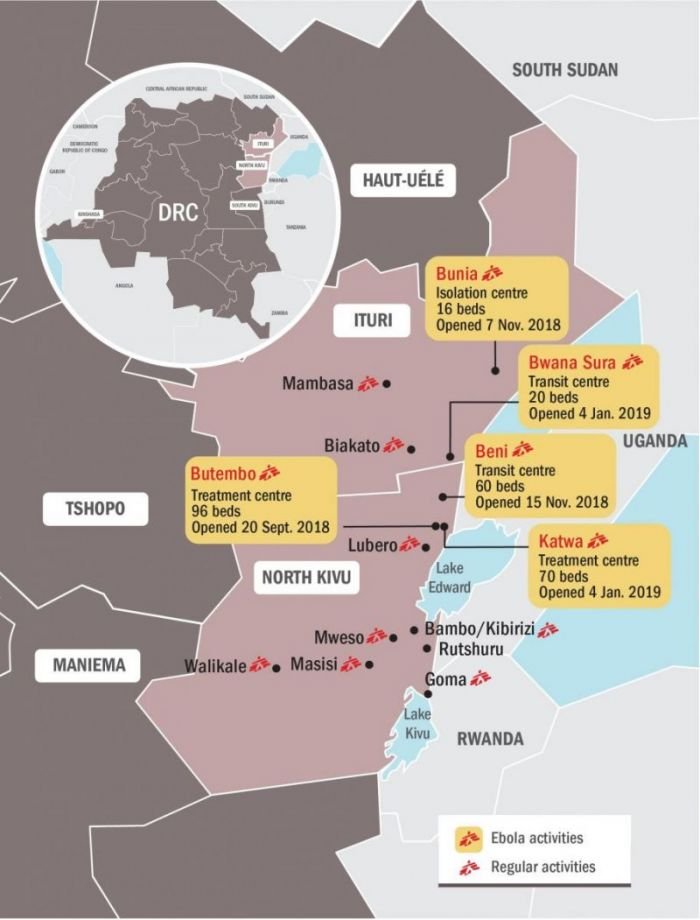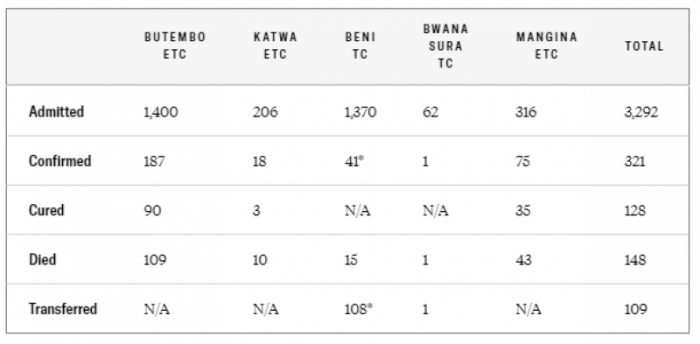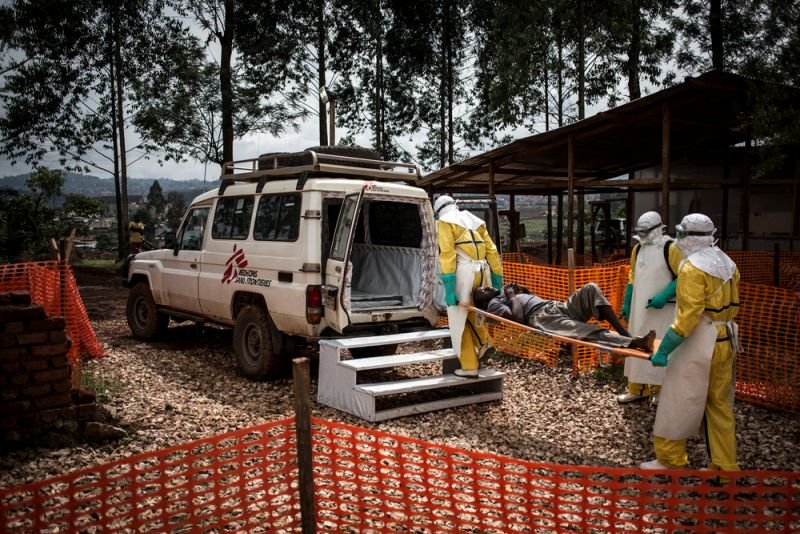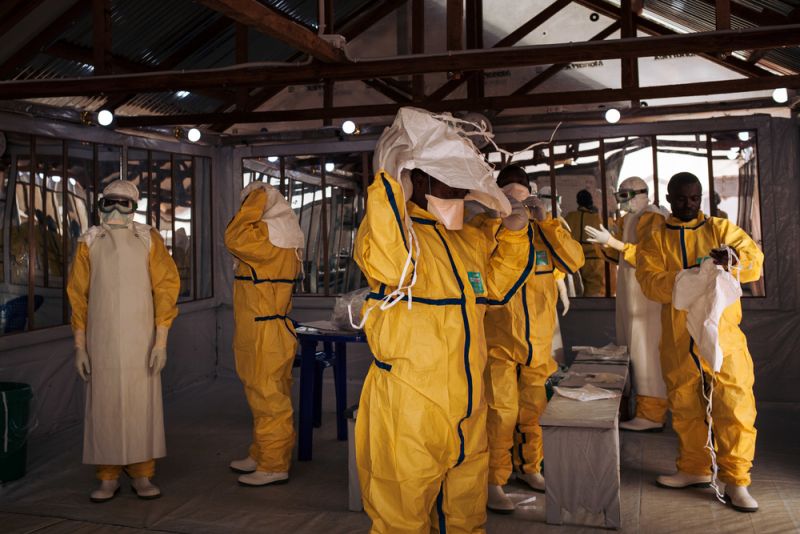Summary
Democratic Republic of Congo (DRC) declared their tenth outbreak of Ebola in 40 years on 1 August 2018. The outbreak is centred in the northeast of the country. With the number of confirmed cases passing 680, it is now by far the country's largest-ever Ebola outbreak. It is also the second-biggest Ebola epidemic ever recorded, behind the West Africa outbreak of 2014-2016.
Latest figures - information as of 28 February 20

Retrospective investigations point to a possible start of the outbreak back in May 2018 – around the same time as the Equateur outbreak earlier in the year. There is no connection or link between the two outbreaks.
The delay in the alert and subsequent response can be attributed to several factors, including a breakdown of the surveillance system due to the security context (there are limitations on movement, and access is difficult) and a strike by the health workers of the area which began in May, due to non-payment of salaries.
A person died at home after presenting symptoms of haemorrhagic fever. Family members of that person developed the same symptoms and also died. A joint Ministry of Health/World Health Organization (WHO) investigation on site found six more suspect cases, of which four tested positive. This result led to the declaration of the outbreak.
The national laboratory (INRB) confirmed on 7 August that the current outbreak is of the Zaire Ebola virus, the most deadly strain and the same one that affected West Africa during the 2014-2016 outbreak. Zaire Ebola was also the virus found in the outbreak in Equateur province, in western DRC earlier in 2018, although a different strain than is affecting the current outbreak.
Area
Located in northeastern DRC, the North Kivu province is a densely populated area with approximately 7 million people, of whom more than 1 million are in Goma, and about 800,000 in Butembo. Despite the rough topography and the bad roads in the region, the population is very mobile.
North Kivu shares a border with Uganda to the east (Beni and Butembo are approximately 100 kilometres from the border). This area sees a lot of trade, but also trafficking, including ‘illegal’ crossings. Some communities live on both sides of the border, meaning that it is quite common for people to cross the border to visit relatives or trade goods at the market on the other side.
The province is also well-known for being an area of conflict for over 25 years, with more than 100 armed groups estimated to be active. Criminal activity, such as kidnappings, are relatively common and skirmishes between armed groups occur regularly across the whole area. Widespread violence has caused population displacement and made some areas in the region quite difficult to access. While most of the urban areas are relatively less exposed to the conflict, attacks and explosions have nonetheless taken place in Beni, an administrative centre of the region, sometimes imposing limitations on our ability to run our operations.
North Kivu is also a very rich region with a lot of natural resources (a third of its territory is dedicated to mining exploitation) which is also a political challenge as the province has the reputation of being an area that favours the opposition. The last elections were controversial with the population, who represents 10 percent of the DRC electorate.

BACKGROUND OF THE EPIDEMIC
First declared in Mangina, a small town of 40,000 people, the epicentre of the outbreak appeared to progressively move towards the south, first to the larger city of Beni, with approximately 400,000 people and the administrative centre of the region. As population movements are very common, the epidemic continued south to the bigger city of Butembo, a trading hub. Nearby Katwa became a new hotspot near the end of 2018 and cases have recently been found further south, in the Kanya area. Meanwhile, sporadic cases also appeared in the neighbouring Ituri province to the north, most recently in the Komanda health zone.
Overall, the geographic spread of the epidemic appears to be unpredictable, with scattered small clusters potentially occurring anywhere in the region. This pattern makes ending the outbreak even more challenging. Given the appearance of new confirmed cases ever further to the south, the risk of the epidemic reaching Goma, the capital of the province, is another cause for concern.
EXISTING MSF PRESENCE IN THE AREA
MSF has had projects in North Kivu since 2006. Today, we have regular projects along the Goma-Beni axe as follows:
- Lubero hospital: paediatric/nutrition care and treatment of sexual and gender-based violence.
- Bambu-Kiribizi: Two teams support local emergency room and paediatric and malnutrition in-patient departments, plus care and treatment of sexual and gender-based violence.
- Rutshuru hospital: MSF withdrew from the hospital at the end of 2017. However, in light of the volatile conditions in the region, we have returned to support emergency room, emergency surgery and paediatric nutrition programmes.
- Goma: HIV programme supporting four medical centres (including access to antiretroviral treatment).
Current situation
So far, 18 health zones in North Kivu and Ituri provinces have reported confirmed or probable cases of Ebola. They are:
ITURI
- Mandima
- Komanda
- Nyakunde
- Tchomia
NORTH-KIVU
- Beni
- Biena
- Butembo
- Kalunguta
- Katwa
- Kayina
- Kyondo
- Mabalako
- Mangurujipa
- Masareka
- Musienene
- Mutwanga
- Oicha
- Vuhovi
During the almost six months since the start of this epidemic, the outbreak’s epicentre has moved a few times, initially from the town of Mangina to the much bigger city of Beni, where the number of confirmed cases has recently dwindled. New hotspots and the number of confirmed cases are increasing in Butembo, particularly the commune of Katwa and in rural areas such as Kalenguta or Kyondo.
The fact that some of the new cases are not linked to any previously known chains of transmissions is a concern, as it makes it more difficult to trace contacts and control the evolution of the outbreak. Katwa in North-Kivu is currently the main hotspot of the outbreak, with two-thirds of the new cases (68 cases out of 104) having been recorded there during the last three weeks.
Elections impact Ebola treatment
On 20 December 2018, it was announced that the long-awaited presidential elections originally scheduled for 22 December were postponed to 30 December. This decision caused tensions throughout the country, especially in areas such as Beni and Butembo, strong opposition strongholds. On 26 December, the national electoral commission announced that elections would be further postponed in three areas, including Beni and Butembo, because of the ongoing Ebola outbreak and the risks of attacks.
This announcement resulted in violent protests, especially in Beni, where an MSF transit centre for treatment and screening of suspect Ebola cases was partly vandalized and looted on 27 December. The incident led to the temporary evacuation of the team. Of the 28 patients that were in the transit centre in Bnat the time of the demonstrations, 9 left the centre of their own accord during the unrest; 18 were referred to Alima’s ETC and 1 person was discharged. With no patients left, activities at the Beni transit centre remained on standby until 30 December. After reassessing the situation, the centre opened again on 1 January 2019 and is now fully operational.
During the same incidents in late December, several health centres in and around Beni were damaged during protests. Some of the health centres targeted by the unrest had received support from our IPC (Infection Prevention and Control) teams to be able to properly screen and refer patients showing symptoms compatible with Ebola. The impact of these attacks has both reduced people’s access to general healthcare and reduced the number of facilities equipped to screen and refer suspect Ebola cases. During the peak of the unrest, we had to temporarily limit all activities outside the transit centre in Beni and the treatment centres in Butembo and Katwa.
With the temporary closing of the Beni transit centre and the suspension of external activities, we face the additional challenge of an accumulated delay in screening and treating potential confirmed cases, as well as identifying their contacts. In addition, suspect patients might have been contaminated inside health structures, accelerating the spread of the disease. Sick people have been known to visit more than one health centre before being identified as suspect cases and referred to an Ebola Treatment Centre. This work is also made more difficult by the relative inaccessibility of parts of the region due to the ongoing insecurity.
Since the beginning of the outbreak, almost 6,000 contacts have been identified and more than 5,100 followed up by the Congolese Ministry of Health. Nearly 17,850 contacts have been vaccinated. The contact tracing and follow-up is done by the Ministry of Health with a team of epidemiologists.
The response to the current outbreak
The DRC Ministry of Health (MoH) is leading the outbreak response, with support from WHO. The MoH team sent to coordinate the response in Beni was dispatched from Kinshasa and is the same team that coordinated the response in Equateur province. The WHO emergency pool was mobilised in the area upon the declaration of the outbreak.
MSF Ebola treatment centres (ETC) and transit centres (TC) numbers on 27 January 2019

* Confirmed patients are referred for treatment to Alima ETC immediately after we received the positive result.
The total figures includes data from Beni, Butembo , Katwa, Komanda, Mangina since the beginning of the outbreak.
Total number of people received by MSF: 3,292
Total patients confirmed with Ebola treated by MSF: 321

At the Ministry of Health’s request, we are part of the national task force coordinating the intervention on several pillars of the response:
- Caring for patients affected by the virus (in ETCs in Butembo and Katwa) and treating and screening suspect cases (in TCs in Beni, Bunia, Bwana Sura and Kayna);
- Communication and health promotion in communities;
- Vaccination of frontline workers in Ituri, Katwa/Butembo, Beni, Lubero;
- IPC (Infection Prevention & Control): protecting local health structures (and their workers) by helping with screening patients at the entrance, hand and foot disinfection, capacity for short-term isolation of suspect patients and decontamination of the facilities where confirmed Ebola patients have transited;
- Training staff;
- Supporting surveillance activities.
In total, more than 200 MSF staff members are currently working in Ebola projects in North Kivu and Ituri. This excludes Ministry of Health (MoH) personnel working in MSF structures, in order to keep a clear distinction between MSF and MoH in our public communication.
Isolation, transit and treatment centres
Beni - An isolation centre was built by MSF in August 2018 in Beni and handed over to the Ministry of Health, who assigned it to another NGO, Alima – it is now a treatment centre. On 14 November, we opened a transit centre for suspect cases in Beni and is currently running with a capacity of 60 beds. The transit centre is located approximately 200 metres from the existing ETC supported by Alima. Confirmed cases are transferred by ambulance from the transit centre to the ETC; those who turn out to be negative are referred to other health structures in the area, to facilitate their access to care for other health problems. MSF has a financial agreement with Nyakounde health facility in order to follow-up some medical cases.
Butembo and Katwa - An ETC has been built and is run by MSF in Butembo, a town estimated to be home to 800,000 people, that became a hotspot for the outbreak in November. Butembo reported seeing imported cases from Beni and other surrounding areas. Another Ebola Treatment Centre was opened in the eastern part of Butembo city, falling under the administration of the Katwa health zone. The Katwa ETC was inaugurated on 3 January 2019 and the first patients were admitted the following day. The total capacity will be up to 80 beds by the end of the month. The MSF ETCs in Butembo and Katwa have a capacity of 96 and 52 beds, respectively.
The Katwa ETC was violently attacked on 24 February, and partly burnt, forcing us to transfer the patients and suspend activities in the centre. Just days later, the ETC in Butembo was likewise attacked, forcing us to evacuate staff and to suspend all activities in both Butembo and Katwa, the current epicentre of the outbreak. The Butembo ETC has since reopened, but is now being run by the MoH and WHO.
Bunia - During the first week of November, we opened a new isolation centre on the premises of the General hospital in Bunia, Ituri. The centre is currently running with a hospitalisation capacity of 8 beds, as well as a screening point at the entrance (with more than 2,000 people screened each day), and a small isolation unit for suspect cases.
Bwana-Sura (Komanda) - a 20-bed transit centre was opened in Bwana-Sura, Ituri province on 4 January 2019, following alerts of new confirmed cases in the area.
Kayna – On 22 January 2019, MSF opened an isolation centre with 10 beds, which will be soon be replaced by an ETC.
Other sites – An ETC was opened on 12 October following the appearance of confirmed cases in Tchomia, Ituri Province, on Lake Albert (on the Ugandan border). This treatment centre was handed over to the MoH on 5 November, following an extended period with no new cases being reported. MSF supported the Ministry of Health personnel working in the centre by providing training, logistic support and technical expertise.
MSF also operated for a few weeks a 7-bed transit centre in Makeke (on the North Kivu-Ituri border), where suspect patients could be isolated and tested for the virus and transferred to Ebola Treatment Centres in Mangina or Beni. The centre has now closed because the Ministry of Health and IMC (International Medical Corps) opened an ETC in Makeke. MSF is no longer working in Tchomia and Makeke.
MSF first helped to improve an isolation unit for suspect and confirmed cases that the local staff had quickly set up in the Mangina health centre, the first epicentre of the outbreak, where patients were isolated and cared for, while a treatment centre was being built. The treatment centre opened on 14 August. The centre had initially a capacity of 68 beds; it has since been reduced to 24 beds and was handed over to IMC on 7 December as the volume of activity in Mangina dwindled and the focus of the outbreak shifted to other areas. There is currently no MSF activity in Mangina.
Developmental drugs
In our ETCs, our teams have been progressively increasing the level of supportive care (oral and IV hydration, treatment for malaria and other coinfections, as well as treatment of Ebola symptoms), and have also been able to offer new potential therapeutic treatments to patients with confirmed Ebola infection under the MEURI protocol.
A team of clinicians makes the choice on an ad hoc basis between five potential drugs (remdesivir, REGN3470-3471-3479, ZMapp, mAb114 and favipiravir). The treatments are given only with the informed consent of the patient (or a family member if they are too young or too sick to consent) and are provided in addition to supportive care.
These five drugs have not yet passed all steps of clinical testing and we are unable to measure their efficacy - yet their utilization has been approved by the ethical committees of the Ministry of Health and MSF, because it is believed they may improve a patient’s chance to survive. While caution must be exercised, these treatments are an added resource to the response. Because of their untested status, their use is subject to a strict protocol which places particular emphasis on the informed consent of the patient.
On 21 November, the Ministry of Health announced the official start of the randomized clinical trial of ZMapp, Mab114, and remdesivir. Without a general agreement among partners, the previous protocol needed some significant improvements. Some of the main issues to address was the inclusion of REGN-EB3 in the trial, and an adaptation of the analysis model, as the current one is considered not likely enough to yield useful results. The protocol was amended to reflect these concerns and the new version was approved on 24 December. We will implement the protocol in the Butembo and Katwa ETCs. So far, the randomised clinical trial is being conducted only in the ETC run by ALIMA in Beni.
We are training our staff to be able to run the trial in our ETCs. It should start on 30 January in Butembo and at the beginning of February in Katwa.

Infection prevention and control
In addition to patient care in ETCs, we are active in several pillars of the Ebola response. One is ensuring that the health system remains functional for non-Ebola patients and patients do not become infected in health structures, contributing to the spread of the disease.
Health centres that have seen Ebola-positive cases are visited by our teams and decontaminated. We support some of these structures to implement infection prevention and control measures, such as training staff on the proper triage of Ebola suspect cases, setting up isolation areas in case of need, and providing material for all these activities.
Infection prevention and control has been used by MSF in the Beni, Butembo, Katwa, Komanda and Bunia health zones at different times, depending on when and where positive cases are identified. For example, in Beni, we’re supporting 20 health centres with differing volume of activity or number of beds. Most of centres were damaged during the protests. With no activities for two weeks during the unrest, the team is currently doing an assessment of the situation and investigating new health areas.
Rapid response team
One of the critical components of the Ebola response is the ability to react quickly to new alerts, being able to investigate them and decide on setting up new structures for the response. To enable this, we set up a Rapid Response Team (RRT) composed of experienced Ebola staff from other MSF projects: a medical doctor, a nurse, a water and sanitation (watsan) expert, and a community engagement specialist.
The RTT investigated alerts in Luotu, a village outside of Lubero, in response to information of a positive case. The team was not only involved in case investigation but also in building a small isolation unit for suspect cases. As no confirmed cases were found, we withdrew our staff on 27 September from this centre, leaving the structure to the Ministry of Health. The same team was deployed to Tchomia when the first confirmed case appeared there in October 2018.
In December, a second team composed of a team leader, a specialist in community engagement anthropology, an epidemiologist, and a watsan expert started operating in remote rural areas with activities such as pre-triage, decontamination, IPC and community awareness-raising, in an effort to refer as many cases as possible to the treatment centres and limit transmission. The team was put on standby following the increased tensions in late December.
The RRT has recently been dispatched to the Kayna health zone, further south, an area located one day away from Goma by car. The team is generally based in Katwa, which is close to health zones surrounding Butembo city with active Ebola transmission.
Vaccination
We have been involved in the vaccination of frontline health workers, those most exposed to the virus. In total, we have so far vaccinated over 4,800 frontline workers, particularly in the areas along the Ituri-North Kivu border and in Butembo. We will now start vaccination in Bunia.
Surveillance
The surveillance strategy is led by the MoH/WHO. MSF epidemiologists in Beni, Butembo, Katwa and Komanda support the surveillance activities.
Health promotion
Our health promotion teams in Beni, Butembo and Katwa work in support of the IPC teams and vaccination teams, as these activities require intensive communication with the community. The health promotion teams are also in contact with local leaders of several health zones, to exchange information about Ebola and the community. MSF also runs activities in Bunia (Ituri) and in support of the MoH-led vaccination campaigns.
Emergency preparedness
Our regular projects in the North Kivu and Ituri provinces have been supplied with equipment including Personal Protective Equipment (PPE) and installed proper hygiene and infection control protocols to safeguard staff and patients from the risk of contamination, should the epidemic reach these locations.
We remain ready to support the authorities of these – and other – neighbouring countries in the implementation of their response to the Ebola outbreak in DRC.
Find out more about MSF's work in Democratic-republic-congo